“Idem Aliter”, or on Two Descriptions of Diplomatic Journey to Persia in The Poetry of Late Antiquity (Claud. Cons. Stil. I 51–68; Sid. Carm. II 75–88)
DOI:
https://doi.org/10.18778/1733-0319.24.07Keywords:
Claudian, Sidonius Apollinaris, Latin panegyric, Roman-Persian relationsAbstract
Two Latin poets of late antiquity, Claudian and Sidonius Apollinaris, included in their verse panegyrics short descriptions of diplomatic journey to Persia. The first mentioned the mission of Stilicho himself in “Panegyric on the consulate of Stilicho” (400 AD), whereas the latter described the mission of Procopius, father of the honorand in the “Panegyric on the consulate of Anthemius” (468 AD). Since Sidonius was in many ways imitator of Claudian, these pieces show a great deal of similarity both in content and form (especially in wording). However, closer scrutiny enables us to discover some differences in the treatment of Oriental topics as well as in general attitude to the praised heroes. Such an analysis allows us an insight into the image of Iranian world created in the Roman poetry as well as the question of sources used by late Latin poets. This paper can be also treated as a small contribution to the discussion on Sidonius’ imitation of Claudian poetry.
References
Hall, J.B. (red.) (1985). Claudii Claudiani Carmina. Leipzig: Teubner.
Google Scholar
Loyen, A. (red.). (1960). Sidoine Apollinaire. Tome I. Poèmes. Paris: Les Belles Lettres.
Google Scholar
Babnis, T. (2019). „The River Araxes in Roman Poetry”. Classica Cracoviensia 22. 7–46 https://doi.org/10.12797/CC.20.2019.22.01
Google Scholar
DOI: https://doi.org/10.12797/CC.20.2019.22.01
Babnis, T. (2020a). „Eutropius as an Oriental. Building the Invective with References to Orient in the First Book of Claudian’s In Eutropium”. Classica Cracoviensia 23. 7–23 https://doi.org/10.12797/CC.23.2020.23.01
Google Scholar
DOI: https://doi.org/10.12797/CC.23.2020.23.01
Babnis, T. (2020b). Obraz świata irańskiego w poezji rzymskiej (III w. p.n.e. – VI w. n.e.). Kraków: Uniwersytet Jagielloński.
Google Scholar
Blockley, R.C. (1987). „The Division of Armenia between the Romans and the Persians at the End of the Fourth Century A.D.”. Historia: Zeitschrift für Alte Geschichte. 36/2. 222–234.
Google Scholar
Cameron, A. (1970). Claudian. Poetry and Propaganda at the Court of Honorius. Oxford: Clarendon Press.
Google Scholar
Canepa, M.P. (2009). The Two Eyes of the Earth: Art and Ritual of Kingship between Rome and Sasanian Iran. Berkeley–Los Angeles–London: University of California Press https://doi.org/10.1525/california/9780520257276.001.0001
Google Scholar
DOI: https://doi.org/10.1525/california/9780520257276.001.0001
Chauvot, A. (1998). Opinions romaines face aux barbares au IVe siècle ap. J.-C. Paris: De Boccard.
Google Scholar
Dignas, B., Winter, E. (2007). Rome and Persia in Late Antiquity. Neighbours and Rivals. Cambridge: Cambridge University Press https://doi.org/10.1017/CBO9780511619182
Google Scholar
DOI: https://doi.org/10.1017/CBO9780511619182
Doyle, Ch. (2019). Honorius. The Fight for the Roman West AD 395– 423. London–New York: Routledge https://doi.org/10.4324/9781315640792
Google Scholar
DOI: https://doi.org/10.4324/9781315640792
Döpp, S. (1980). Zeitgeschichte in Dichtungen Claudians. Wiesbaden: Franz Steiner.
Google Scholar
Georges, P.B. (1994). Barbarian Asia and the Greek Experience. From the Archaic Period to the Age of Xenophon. Baltimore–London: The John Hopkins University Press.
Google Scholar
Gruen, E.S. (2011). Rethinking the Other in Antiquity. Princeton–Oxford: Princeton University Press.
Google Scholar
Gualandri, I. (2020). Sidoniusʼ Intertextuality. W: Kelly, G., van Waarden, J.A., The Edinburgh Companion to Sidonius Apollinaris. Edinburgh: Edinburgh University Press. 279–316.
Google Scholar
DOI: https://doi.org/10.1515/9781474461702-014
Hall, E. (1989). Inventing the Barbarian. Greek Self-Definition Through Tragedy. Oxford: Oxford University Press.
Google Scholar
Hardie, Ph. (2007). Images of the Persian Wars in Rome. W: Bridges, E. et al. (red.). Cultural Responses to the Persian Wars. Antiquity to the Third Millennium. Oxford: Oxford University Press. 127–143 https://doi.org/10.1093/acprof:oso/9780199279678.003.0007
Google Scholar
DOI: https://doi.org/10.1093/acprof:oso/9780199279678.003.0007
Isaac, B. (2004). Invention of Racism in Classical Antiquity. Princeton–Oxford: Princeton University Press https://doi.org/10.1515/9781400849567
Google Scholar
DOI: https://doi.org/10.1515/9781400849567
Jong de, A. (1997). Traditions of the Magi. Zoroastrianism in Greek and Latin Literature. Leiden–New York–Köln: Brill https://doi.org/10.1163/9789004301467
Google Scholar
DOI: https://doi.org/10.1163/9789004301467
Kelly, G. (2013), Sidonius and Claudian. W: van Waarden, J.A., Kelly, G. (red.), New Approaches to Sidonius Apollinaris. Leuven–Paris–Walpole: Peeters. 171–194.
Google Scholar
Keudel, U. (1970). Poetische Vorläufer und Vorbilder in Claudians De consulatu Stilichonis. Imitationskommentar. Göttingen: Vandenhoeck & Ruprecht https://doi.org/10.13109/9783666251160
Google Scholar
DOI: https://doi.org/10.13109/9783666251160
Kühnen, A. (2008). Die imitatio Alexandri in der römischen Politik. 1. Jh. v. Chr. – 3. Jh. n. Chr. Münster: Rhema.
Google Scholar
Lenfant, D. (2000). Les rois de Perse vus d’Athène. W: Serwański, M. (red.). Les grands hommes des autres. Actes du Xe colloque Poznan–Strasbourg des 4–6 novembre 1998. Poznań: Instytut Historii UAM. 33–49.
Google Scholar
Lerouge, Ch. (2007). L’image des Parthes dans le monde gréco-romain. Du début du Ier siècle av. J.-C. jusqu’à la fin du Haut-Empire romain. Stuttgart: Franz Steinter Verlag.
Google Scholar
Mastrocinque, A. (2017). The Mysteries of Mithras. A Different Account. Tübingen: Mohr Siebeck https://doi.org/10.1628/978-3-16-155118-5
Google Scholar
DOI: https://doi.org/10.1628/978-3-16-155118-5
Montone, F. (2012). Sidonio Apollinare. Carmi 1 e 2. Praefatio e Panegirico per Antemio. Introd., trad., comm. ed Appendici. Napoli: Università degli studi di Napoli Federico II.
Google Scholar
Morgan, J. (2016). Greek Perspectives on the Achaemenid Empire. Persia through the Looking Glass. Edinburgh: Edinburgh University Press.
Google Scholar
DOI: https://doi.org/10.1515/9780748647248
Nathan, R. (2015). „The Ideal Male in Late Antiquity. Claudian’s Example of Flavius Stilicho”. Gender and History 27/1. 10–27 https://doi.org/10.1111/1468-0424.12100
Google Scholar
DOI: https://doi.org/10.1111/1468-0424.12100
O’Flynn, J. (1983). Generalissimos of the Western Roman Empire. Edmonton: The University of Alberta Press.
Google Scholar
Paratore, E. (1966). La Persia nella letteratura latina. W: Atti del convegno sul tema: La Persia e il mondo greco-romano. Roma: Accademia Nazionale dei Lincei. 505–558.
Google Scholar
Roberts, M. (1989). The Jeweled Style. Poetry and Poetics in Late Antiquity. Ithaca–London: Cornell University Press.
Google Scholar
Rosivach, V.J. (1984). „The Romans’ View of the Persians”. The Classical World 78/1. 1–8 https://doi.org/10.2307/4349657
Google Scholar
DOI: https://doi.org/10.2307/4349657
Salamon, M. (1975). Rozwój idei Rzymu–Konstantynopola od IV do pierwszej połowy VI wieku. Katowice: Wydawnictwo Uniwersytetu Śląskiego.
Google Scholar
Sánchez-Ostiz, Á. (2018). Claudian’s Stilicho at the Urbs. Roman Legitimacy for the Half-Barbarian Regent. W: Burgersdijk, D.P.W., Ross, A.J. (red.). Imagining Emperors in the Later Roman Empire. Leiden–Boston: Brill. 310–330.
Google Scholar
Spawforth, A. (1994). Symbol of Unity? The Persian Wars Tradition in the Roman Empire. W: Hornblower, S. (red.), Greek Historiography. Oxford: Clarendon Press. 233–247.
Google Scholar
Stoehr-Monjou, A. (2020). Sidonius’ Panegyrics. W: Kelly, G., van Waarden, J.A., The Edinburgh Companion to Sidonius Apollinaris. Edinburgh: Edinburgh University Press. 317–340.
Google Scholar
DOI: https://doi.org/10.1515/9781474461702-015
Styka, J. (2008). Sydoniusz Apollinaris i kultura literacka w Galii V wieku. Kraków: PAU.
Google Scholar
Vasunia, Ph. (2007). Zarathushtra and the Religion of Ancient Iran. The Greek and Latin Sources in Translation. Mumbai: The K. R. Cama Oriental Institute.
Google Scholar
Watson, L. (1997). Sidonius Apollinaris’ Carmina 1 and 2. A Commentary. London: University of London.
Google Scholar
Wilczyński, M. (2018). „Droga na szczyt i droga w otchłań – kilka uwag o karierze Flawiusza Stilichona”. Vox Patrum 38. 681–705 https://doi.org/10.31743/vp.3281
Google Scholar
DOI: https://doi.org/10.31743/vp.3281
Wissemann, M. (1982). Die Parther in der augusteischen Dichtung. Frankfurt am Main–Bern: Peter Lang.
Google Scholar
Downloads
Published
How to Cite
Issue
Section
License

This work is licensed under a Creative Commons Attribution-NonCommercial-NoDerivatives 4.0 International License.












